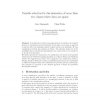Free Online Productivity Tools
i2Speak
i2Symbol
i2OCR
iTex2Img
iWeb2Print
iWeb2Shot
i2Type
iPdf2Split
iPdf2Merge
i2Bopomofo
i2Arabic
i2Style
i2Image
i2PDF
iLatex2Rtf
Sci2ools
GFKL
2005
Springer
2005
Springer
Variable Selection for Discrimination of More Than Two Classes Where Data are Sparse
In classification, with an increasing number of variables, the required number of observations grows drastically. In this paper we present an approach to put into effect the maximal possible variable selection, by splitting a K class classification problem into pairwise problems. The principle makes use of the possibility that a variable that discriminates two classes will not necessarily do so for all such class pairs. We further present the construction of a classification rule based on the pairwise solutions by the Pairwise Coupling algorithm according to Hastie and Tibshirani (1998). The suggested proceedure can be applied to any classification method. Finally, situations with lack of data in multidimensional spaces are investigated on different simulated data sets to illustrate the problem and the possible gain. The principle is compared to the classical approach of linear and quadratic discriminant analysis. 1 Motivation and idea In most classification procedures, the numb...
| Added | 27 Jun 2010 |
| Updated | 27 Jun 2010 |
| Type | Conference |
| Year | 2005 |
| Where | GFKL |
| Authors | Gero Szepannek, Claus Weihs |
Comments (0)

